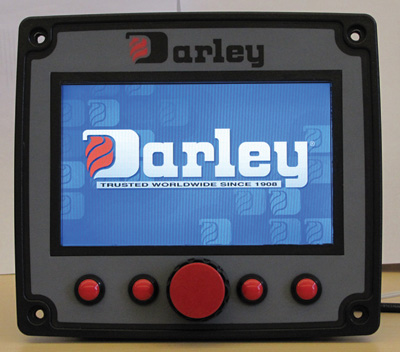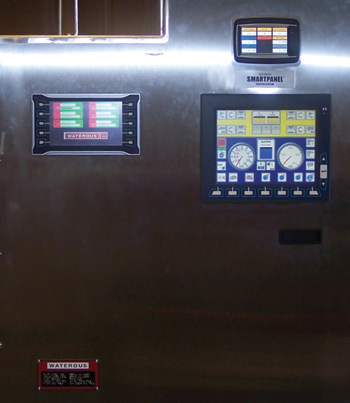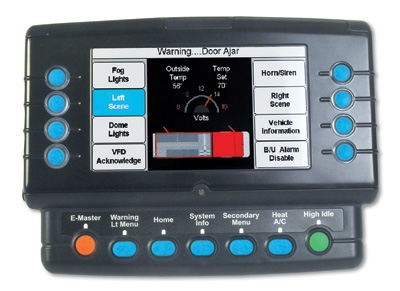Alan M. Petrillo
Evolving computerized technology has had an impact on many facets of modern life, allowing people to be connected in ways that even a dozen years ago might have seemed a pipe dream. And, that evolving technology has driven the development of flat-panel controllers-iPad-like touch and display screens-to help change the face of all types of fire apparatus, from providing total control of pumpers and aerials to specialized monitoring and control of dedicated apparatus functions.
Not Pervasive Yet
Deven Patel, an electrical engineer for Fire Research Corporation (FRC), says that although flat-panel screens are starting to be used to control fire apparatus, it will take a number of years to refine the brightness and reliability of the screens for the environment they are intended to be used in. “There is no unit that is truly sunlight-readable yet,” Patel says, “and the temperature level that the LCD screen works at is very low compared to what we need. LCDs are backlit, so they’re not capable of running at higher temperatures-they max out at around 80 degrees Centigrade.”
Patel notes that other issues surrounding the use of LCD units as flat-panel controllers are cold temperatures and the dexterity of gloved firefighters in pushing buttons, whether on a touch screen or buttons stacked alongside the viewing area. “There are two ways to approach the inputs a firefighter will make,” Patel says, “either using the LCD screen itself for an input or external membrane switches that are on the perimeter of the screen.”
Screen size is another factor to be considered in having a flat-panel controller, he adds, noting that the most common size currently being used is a seven-inch diagonal screen. “It offers a brighter screen and contrast for a reasonable cost,” Patel says. “It’s more expensive when you go larger and brighter with the screen.”
 |
| (1) W.S. Darley & Co. makes the Smart Panel controller, a nontouch-screen model that is accessed through buttons and a control knob aligned along the bottom of the unit. (Photo courtesy of W.S. Darley & Co.) |
Jack McLoughlin, FRC’s president, says his company is developing a flat-panel controller with Elkhart Brass that is built for industrial use and can control all the functions on a fire vehicle, including pump-panel controls, pressure regulator and governor, opening and closing all valves, tank level indicators, valve positions, water pressure, and water flow. However, the current version requires a sunshade when used in direct sunlight. “This controller is experimental,” McLaughlin says. “It needs to be brighter and we are still resolving some user-friendliness issues. The controller has to be intuitive to use; it has to look like the pump panel.”
Systems Integration
Sean Tillinghast, vice president of Weldon, a division of Akron Brass Company, says a flat-panel controller is simply a reconfiguration of gauges, buttons, and switches that would typically be found on a pumper or aerial. “What is fundamentally changing the operation and control of fire vehicles is systems integration,” Tillinghast says. “The human interface on fire apparatus ultimately needs to be what is most durable, reliable, accessible, and usable by the firefighter.”
Tillinghast notes that the power trains, the brakes, and the transmissions on all fire trucks have “talked to each other since the 1990s” through the J1939 CANBUS system. “Engine controls, the pump and its controls, valves, and electrical controls all are being integrated with software and controlled from a display to work harmoniously to perform tasks that have, in the past, taken a lot of operator skill,” he points out.
 |
| (2) The SMARTPANEL automatic control system is available in four-, seven-, and 11-inch touch-screen versions and can be located anywhere on a fire apparatus. (Photo courtesy of Waterous.) |
Weldon has upgraded its Vista 4 controller with an LCD touch screen, Tillinghast says, that is an operator’s station-not only a screen accessible to officers. “It’s being used in the line of duty by firefighters to perform a number of functions through the screen itself,” he adds.
Weldon uses resistive touch technology, Tillinghast says, which involves film layers of touch elements separated by air gaps. “In an optical system, it adds more reflective properties with every air gap you include,” he notes. “However, we have to overcome the ambient conditions outside and make the screens brighter. But, that makes the screen hotter, which degrades the life of the LCD.”
To Tillinghast, a touch-screen controller should not be the only point of control on a fire truck. “When life-critical functions are in play, you should have more than one point of control on the vehicle,” he says.
Weldon developed its VMUX operating system in the late 1990s and has continually refined the software and hardware used on it, Tillinghast says. “We now have connectivity with our Navigator among all the vehicle’s systems so that all pumps, valves, drive train, and lighting components are connected into the network and can share information. We can also push that information out wirelessly to, for example, a city water department to show how much water we’re flowing, how much is being drawn from the city system, and whether additional support will be needed.”
Tillinghast thinks that flat-screen controllers serve the purpose of making a firefighter’s job a little easier. “What these flat-screen controllers have empowered is the decluttering of equipment on vehicles,” he says. “A screen next to the driver gives key functions for driving, where he can select run mode options, lighting, sirens, signals, camera shots of the sides or back of the vehicle, and GPS changes for routing. When the vehicle operator parks at the scene, he might change the screen to pump-related functions, or if he’s driving an aerial, he might go to an outrigger leveling screen.”
The Gateway
Don Sjolin, chief operating officer of Elkhart Brass, points out that flat-panel controllers are simply the interface to the controls on a fire truck. “Most of the time, they are the interface control, but they may not be the only way to control that vehicle,” Sjolin says. “The real changes are in the integration of all the controls on a fire truck, where they are not only integrated but programmable. But right now, we’re simply accessing those controls and turning them on and off.”
Sjolin agrees that flat-panel controllers still have some way to go in being bright enough to use in direct sunlight and to withstand temperature extremes. “In the case of a pumper with an enclosed cab in a cold-weather area, the inside of the cab is protected and the ambient light is not high, so the [brightness] requirement for a flat-panel interface device is relatively low,” Sjolin says. “But where that flat-panel device resides on the exterior of the vehicle, it must be a hardened device to withstand the weather and must have extremely bright lighting to be seen in sunlight. But, all these challenges can be overcome.”
Sjolin says that the construction and outdoor kiosk industries are driving the flat-panel control industry, and the fire industry’s challenge is to integrate them into fire trucks. “Where we see the biggest challenge is the interface,” Sjolin says. “We’re on the road now testing units with firefighters to determine how they want to use the information the controller gives them. How the buttons are to be configured is not clear yet-we need to get a good handle on that from the firefighters who will be using the controllers.”
Variety of Needs
Eric Combs, Elkhart’s product market director for the OEM division, says there is a wide spectrum of wants and desires from firefighters when it comes to flat-panel controllers. “The iPad typically comes up as an example that is very intuitive and requires very little training,” Combs says. “The other side of the spectrum sees flat-panel controllers as an opportunity to take a bank of valves and consolidate them into one unit and then progress from there.”
Ultimately, different forms of controllers will have different levels of integration, Combs believes. “It could be a touch-screen model that handles all the functions or a dashboard with knobs,” Combs says. “Each fire truck is tailored to the needs of that particular department, so there’s no reason why controllers couldn’t be tailored too.”
Combs points out that the basic foundation of flat-panel controllers is their flexibility. “The controller can monitor everything,” he says. “How it interfaces-by knob, lever, or touch-is the firefighter’s choice. It is much more economical to have customized software in a controller than customized hardware, so applications can be tailored to a certain type of need of the fire department.”
Steve Toren, director of North American sales and marketing for Waterous, says that SMARTPANEL is the Waterous trademark for its automatic control system. “The J1939 CANBUS capability allows us to take the functions in the pump compartment and apply that functionality to all of the truck’s other functions,” Toren says.
Toren notes that Waterous offers touch screens in four-, seven-, and 11-inch models. For example, a seven-inch touch screen might be used in an apparatus cab for shifting functions, while an 11-inch screen might be seen on the vehicle’s pump panel, he says. “The screen’s applications look like those on an iPhone, where you push the application and it takes you to the screen for that particular function,” Toren says. “Changes can be made under that application, and then the operator can return to the home button or go to another application, perhaps lighting or engine control.”
Being able to position flat-screen controllers in almost any location on a fire truck gives them great appeal, Toren believes. “You can have one controller at the driver’s side pump panel, one in the cab, one on the officer’s side, and another in the back of the apparatus,” he says. “Each will function so that when using that particular panel, it will take over the functioning of the apparatus. You can also program the system software code so that when one panel is being used, the others are locked out as a safety measure.”
Like Two Pump Operators
Shane Sullivan, design engineer for W.S. Darley & Co., says that Darley’s Smart Control serves as a relief valve while monitoring all pump pressure and suction activity. “Smart Control can monitor up to 15 discharge lines so they can be read on a single panel,” Sullivan says. “It also monitors all the vehicle’s sensors and can control all pump and engine functions.”
Smart Control’s main screen gives information about the vehicle’s main gauges and some diagnostics, and other screens can be added to control various systems on a vehicle, such as valves, lighting, or other equipment.
Jason Darley, Darley’s pump sales manager for North America, says his company decided not to use a touch screen for the Smart Control “because we were concerned that a firefighter’s gloved hand on a fire scene might leave a residue that could affect the operation of the controller.” Instead, Darley used a screen flanked by a series of buttons and one main control knob, which is used to make selections on the screen. “The main knob also can serve to control the engine by acting as a standard throttle or can be used to control the valve positions on various discharges,” Darley points out.
The waterproof Smart Control uses a seven-inch display screen but can be made larger to accommodate additional buttons if necessary, Darley adds. Multiple controllers can be installed at any location on a vehicle, Darley says, “So, positioning is limitless because there are no mechanical controls-it’s only a matter of wiring.”
 |
| (3) Weldon, an Akron Brass division, makes the V-MUX Vista IV control interface, shown here in a display that can be mounted in a vehicle cab, to control lighting, sirens, and other vehicle functions. (Photo courtesy of Akron Brass, Weldon Division.) |
Keeping It Simple
Chuck Hutchins, applications manager for ES-Key and electronic products at Hale Products Inc., thinks that having a visual graphic reference is much easier to understand than a panel full of rocker switches. “The amount of information available in one graphically represented place is making firefighters so much more intelligent about their applications,” Hutchins says.
ES-Key is Hale’s multiplexing system that runs behind the Class 1 (a division of Hale) Ultra View display, which Hutchins calls “fairly revolutionary for our mobile market because it is completely waterproof and sunlight-visible. The fact that they are sunlight-visible,” he says, “means you can mount them anywhere. The display uses a chemical bonding process between the LCD and the front glass to make it visible in sunlight.”
Hutchins says the single biggest advantage of a flat-screen controller “is the sheer volume of information that it can show to the operator and display it in real time.” ES-Key also talks the same language as other components using the J1939 CANBUS system on a vehicle, so there are no extra components needed to make it compatible, Hutchins points out.
Another advantage, he says, is the ability to have multistation control. “The possibilities with this technology are limited only to graphics ability and imagination,” Hutchins observes. “We see flat-panel controllers becoming more popular on fire trucks as younger firefighters get into more elevated positions in fire departments,” he notes. “They are using smart phones, Xboxes, and Nintendos, so the technology is intuitive for them. Once they’re making the decisions on the operations and the apparatus, they’ll embrace this type of technology.”
ALAN M. PETRILLO is a Tucson, Arizona-based freelance writer and is a member of the Fire Apparatus & Emergency Equipment editorial advisory board. He served 22 years with the Verdoy (NY) Fire Department, including in the position of chief.

